How to Spy on Competitor? Keywords, Ads & More [16 Proven Techniques]
Table of contents
Curious about what organic keywords your competitors rank for? How many backlinks do they have? What is the sentiment around their brand? You can easily check it. Actually, you can check much more information about them. So, let’s discover how to spy on competitor – legally and smartly!
To spy on competitor sounds like a sneaky tactic. But in reality, it’s a totally ethical and legal way of gathering publicly available information to understand your rival’s strategies and performance.
It involves analyzing its social media activity, marketing strategy, website, customer reviews, and more. All that to identify your competitor’s strengths & weaknesses and discover your opportunities for differentiation and growth in the market.
00 Find your competitors
I decided to start from step zero, which is an absolute must: before diving into analysis, it’s crucial to identify your main competitors.
I know, it sounds obvious. But from my experience, many people work in chaos. Instead of sacrificing 10 minutes to create a list of competitors, they start doing everything at once.
They end up jumping from one page Tab to another and – ultimately- waste much more time than they would spend listing their competitors first.
Okay, and how to find your competitors?
Start with direct competitors, so the businesses that target the same audience and operate in the same or similar niche.
Also, consider indirect ones that may target slightly different markets but still compete with you for consumer attention.
Spy on your competitors! Detect their online mentions!
A good starting point for such research is Google or ChatGPT. Seriously, these two sources can do quite a comprehensive competitor identification.
For example, I prompted ChatGPT to provide me with a list of the top 5 competitors of the Patagonia brand.
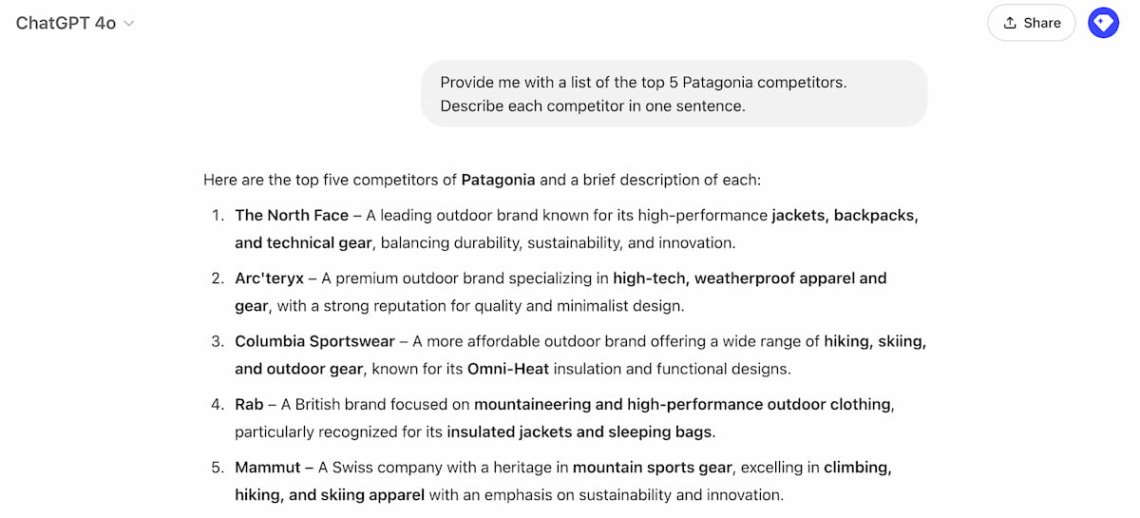
Also, you can use SEO software like Semrush or Ahrefs. Those tools, based on keywords, detect top competing domains. Here you can see the organic competitors of Patagonia:
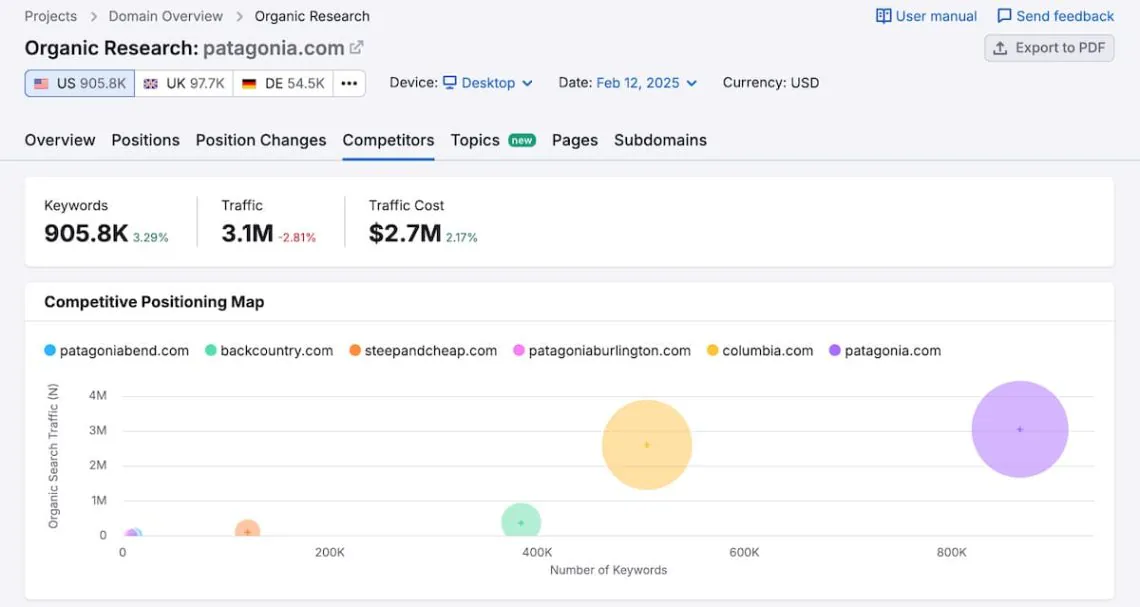
And here you can check paid competitors of Patagonia:
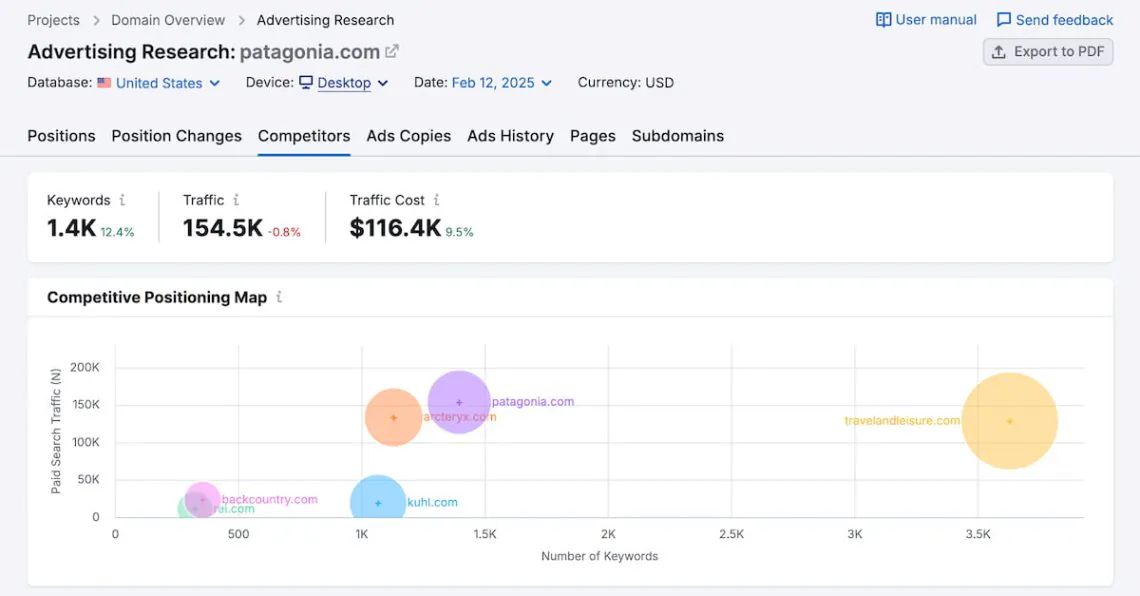
Now, let me present 16 techniques to help you discover how to spy on competitors.
01 Keywords
Competitor websites often serve as the central hub for a company’s activities, showcasing their products, services, campaigns, and content strategy.
Therefore, your competitor’s website is the first place you should explore to gather insights. Let’s start with what matters a lot in driving website traffic: keywords.
To spy on competitor keywords, we need to dive into your competitors’ SEO strategies.
There are several tools available that can help you uncover the organic and paid keywords your competitors are ranking for. Semrush and Ahrefs are the most popular ones.
Let’s discover how many keywords the Patagonia brand ranks for using the Semrush tool.
Organic keywords
Start from the “Organic Research” tool and enter your competitor’s domain.
Then, go to the “Positions” tab and select “Organic” to see the keywords they rank for, search intent, SERP features, traffic, volume, CPC, keyword difficulty (KD), and more.
Here, you can apply more or less advanced filters to adjust the view to your needs.
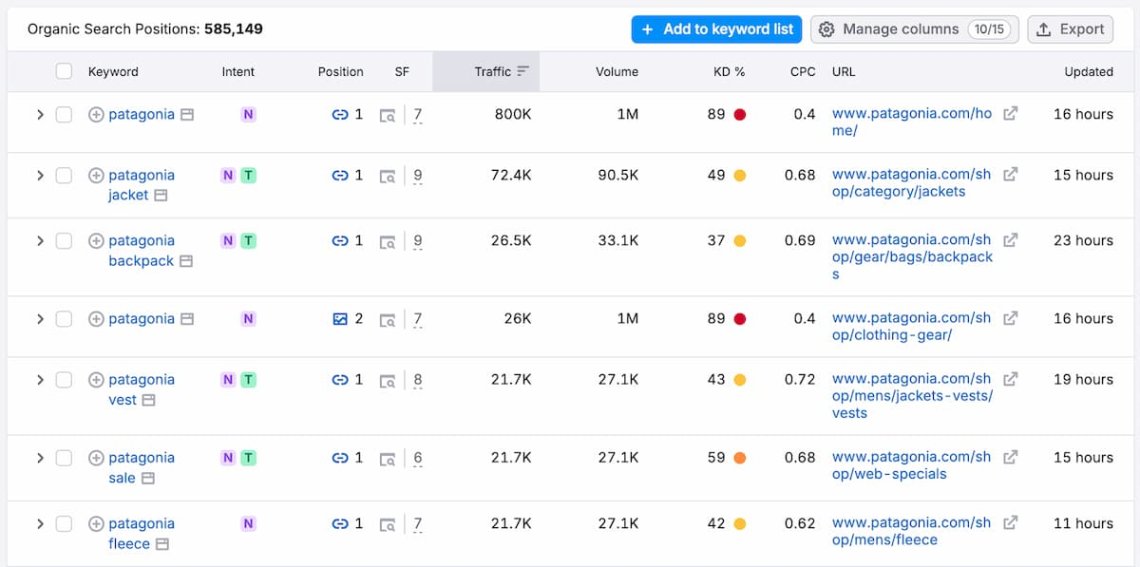
Now it’s time for analysis. Look for your competitor’s top-performing keywords that bring traffic to their website.
In addition to high-volume keywords, pay attention to long-tail keywords. Implementing them into your content strategy can be a game changer. Okay, but what are they?
Long-tail keywords are longer, more specific phrases people search for. For example, a typical keyword is “best hiking boots,” whereas a long-tail keyword is “best hiking boots for wide feet”.
Such keywords are more precise and often have lower search volumes, but they can be valuable for targeting a niche audience.
Also, pay attention to the keyword difficulty (how hard it is to rank for a keyword).
I wanted to find high-volume keywords with low keyword difficulty that bring traffic to the Patagonia website.
So, I filtered the data. Also, I excluded keywords containing “Patagonia.” Here you can see the results:
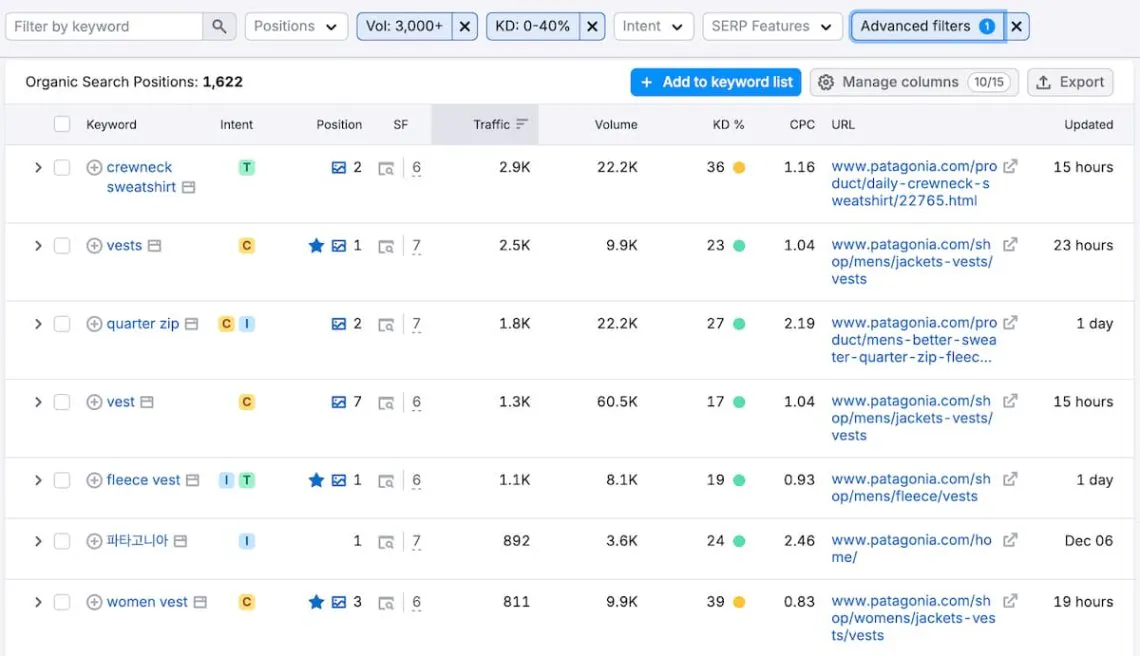
Thanks to this analysis, I found highly popular products available at the Patagonia store.
With the “Organic” feature, you can also check the keywords of specific URLs.
For example, the Patagonia homepage ranks for over 41,000 related keywords, and 300 of them are in the top position on Google. That’s an impressive result!
Start spying on your competitors now!
Paid keywords
Let’s discover paid keywords for which your competitor wants to rank. I’m sure they will be very valuable for your business. Again, we will use Semrush.
Go to the “Advertising Research” section. The Patagonia brand has advertisements for more than 1,700 keywords:
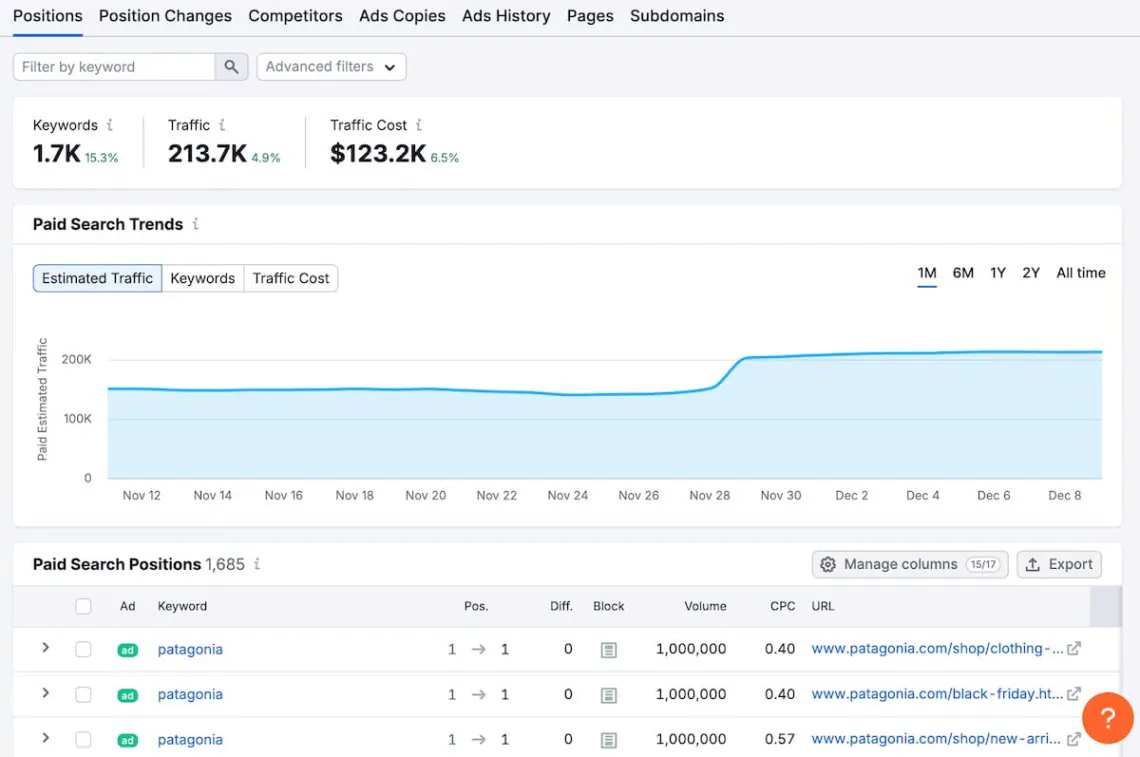
You can filter the data to discover the top high-performing paid keywords. These are the keywords they are likely investing the most in.
Also, look for keywords that your competitors are targeting in search engines but you are not.
Remember that competitor analysis is an ongoing process. So, continuously monitor your competitor’s organic and paid keywords.
02 Mentions
Monitoring online conversations and mentions is a great way to spy on your competitors.
Okay, but how to get such insights in practice? In fact, it’s really easy!
All you need to have is a great media monitoring tool like Brand24. It allows you to track mentions across:
- Social media platforms, such as Facebook, Instagram, X (Twitter), YouTube, TikTok, LinkedIn, Reddit, Telegram, and Twitch ;
- Websites, blogs, forums, video platforms, podcasts, news sites, and other websites;
- Newsletters and review sites.
Brand24 delivers many valuable insights that you can implement into your marketing strategy. It also helps you conduct an advanced, multi-layered competitor analysis.
Spy on your competitors! Detect their online mentions!
You can use it to:
- Detect the main source of competitor mentions,
- Find the most popular mentions,
- Measure the reach mentions bring to competitors,
- Do the competitor’s sentiment analysis, so check whether mentions are positive, neutral, or negative.
Let’s do a quick example.
Imagine you’re representative of a DJI brand (a drone and action camera brand). Your competitor to spy on is the GoPro brand. You open the Brand24 project, visit the Mentions tab, and do a quick overview.
It turns out that in January 2025, GoPro was mentioned over 85,000 times.
Thanks to the Mentions & Reach chart, you can easily identify any sudden increases or changes in the trend of the brand mentions.
And that’s not all!
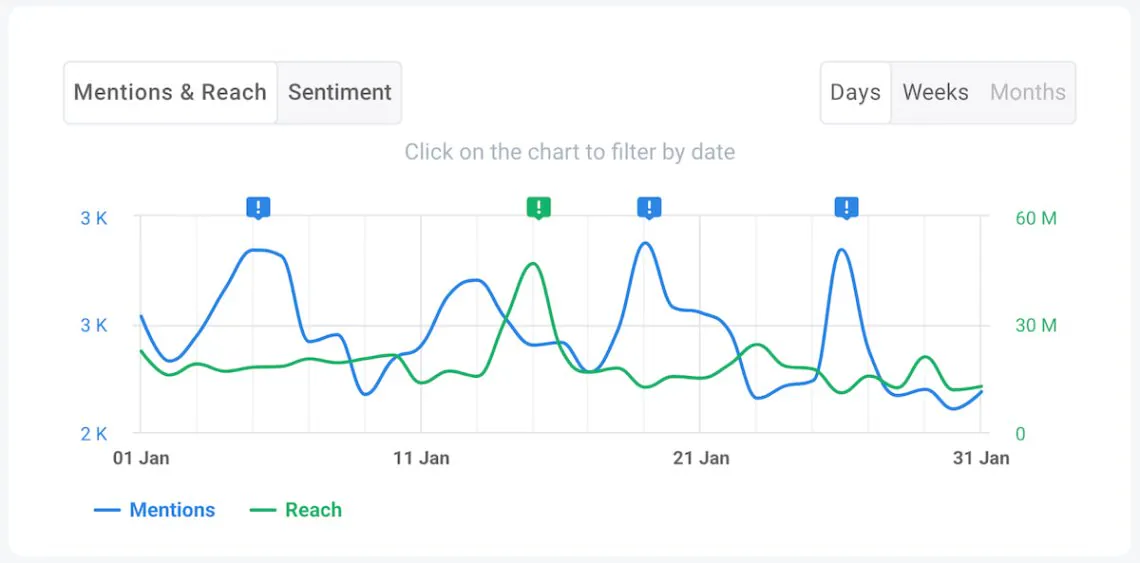
Those exclamation marks indicate anomalies identified by Brand24’s AI Anomaly Detector.
In short, whenever something unexpected happens in you or your competitor’s project (like a sudden spike in mentions volume), the Detector looks for the most possible cause and summarizes it in one or two sentences.
It turns out that the huge increase in GoPro mentions was related to the extreme skiing clip shot by Blaine Gallivan.
For GoPro, it’s evidence that their marketing strategy (strong focus on user-generated content) pays off!
And that’s a great inspiration for the DJI brand.
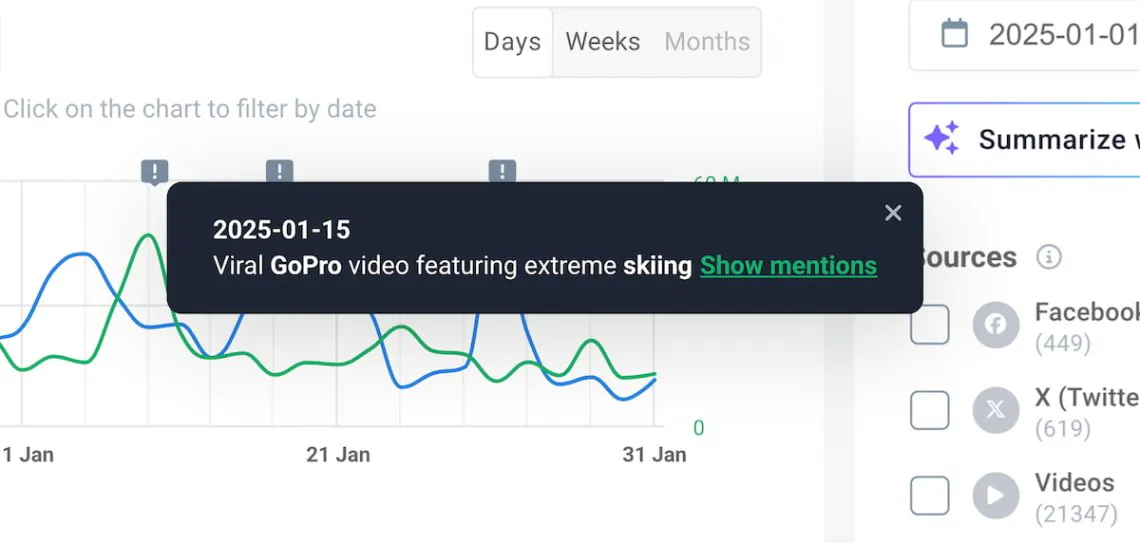
Sign-up for the Brand24 trial and spy on your competitor!
So, now you know how many mentions your rival receives and what brings it even more interest. It’s time to compare their results to yours.
Actually, thanks to the comparison feature of Brand24, you can compare your brand with one or more competitors.
Below, you can see the DJI vs. GoPro summary.
In general, the DJI beats GoPro in most categories. The thing DJI should definitely take care of is its positive-to-negative mentions ratio.
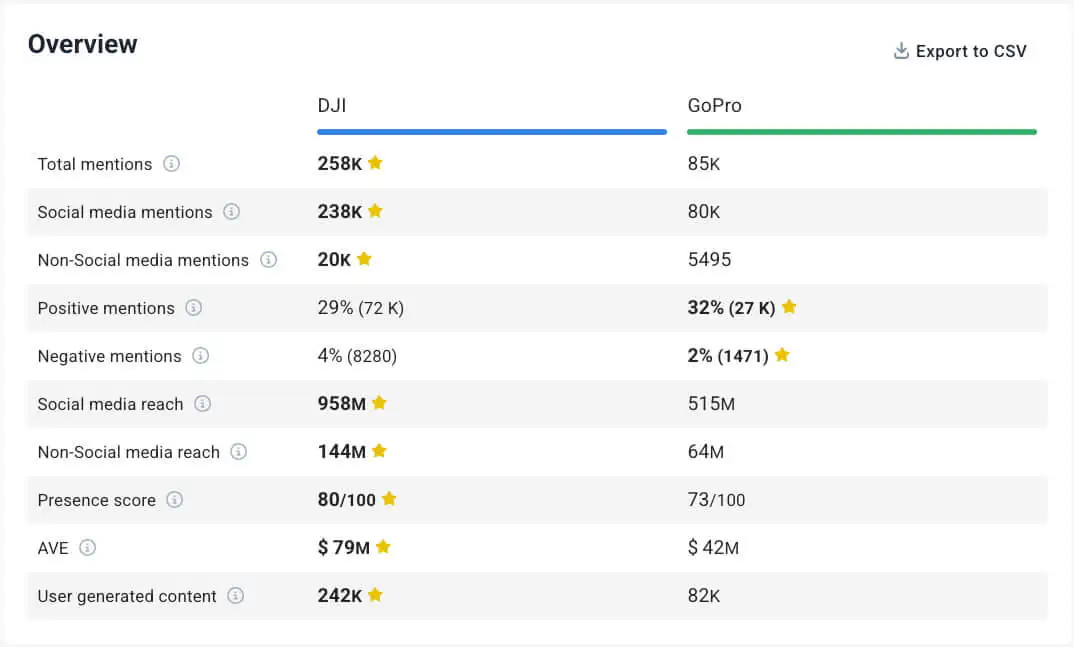
Brand24 is really one of the most amazing competitive intelligence tools. We’ll explore its capabilities in that matter later.
Now, let’s move to other techniques that focus more on your competitor’s advertising efforts.
Read more: Learn about Backlinks Checker
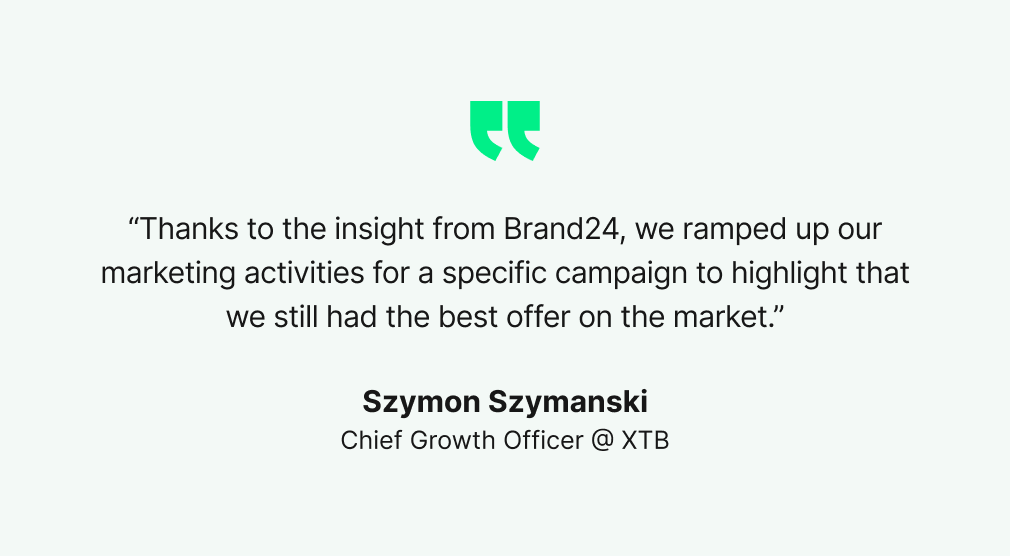
Discover our client’s success story — read the case study.
03 Paid ads copy
You might be surprised that – next to its powerful SEO features – Semrush is a great ad spy tool!
It allows you to get a comprehensive overview of your competitors’ ad copy, including headlines, descriptions, and display URLs.
You can click on your competitors’ ads to visit the landing pages directing users. By analyzing the messaging, design, and user experience on these pages, you can improve your ads strategy.
The tool also shows domain ad history, so you can track whether your rival made any ad changes.
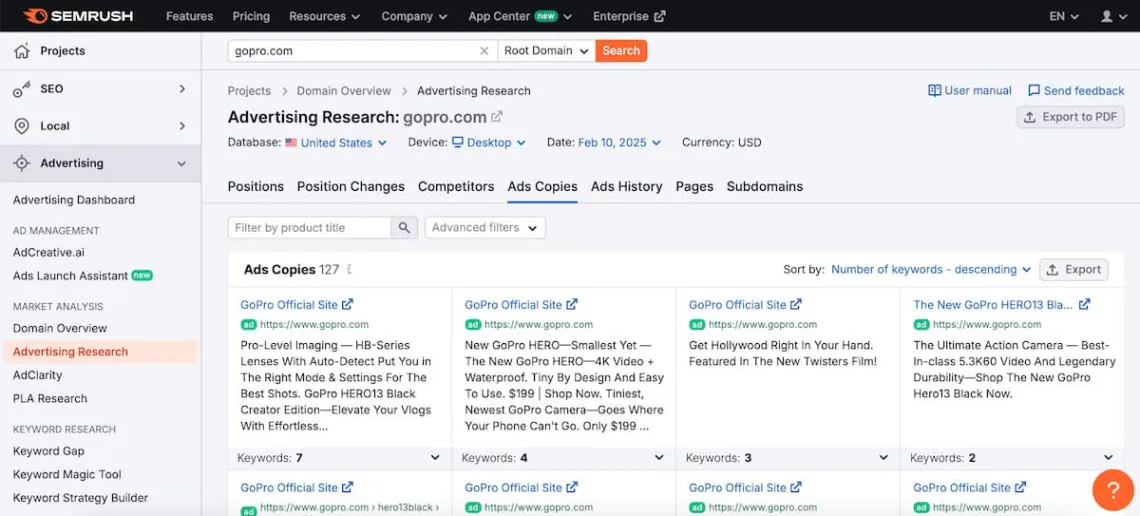
Spy on your competitors! Detect their online mentions!
04 Google ads
Spying on competitors’ Google ads is relatively easy.
Type your competitor’s name in Google search. Find the ad and click three dots. You’ll discover the ad report with insights about an advertiser. Then click “See more ads this advertiser has shown using Google.”
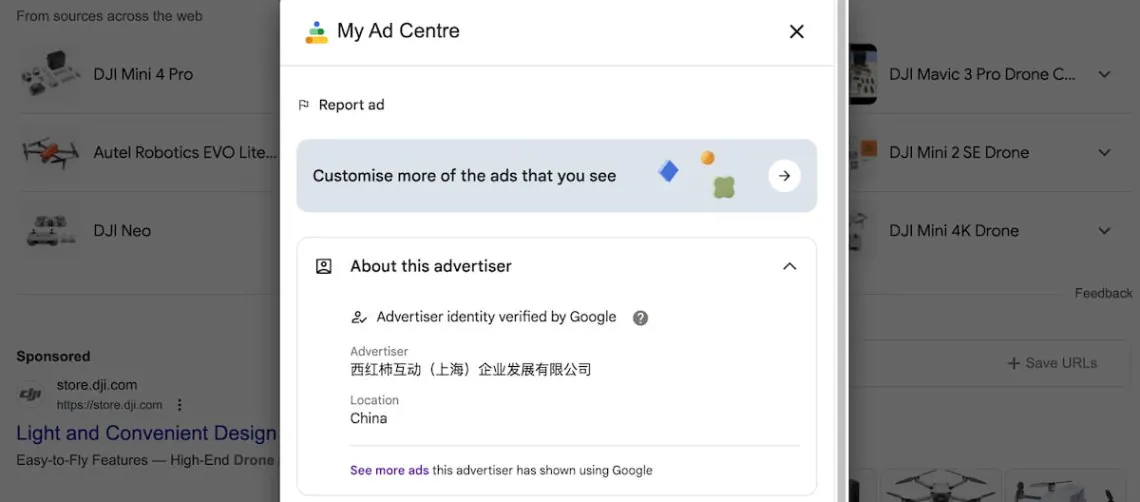
Then you will be redirected to the Ads Transparency Center. It will show you a preview of ads. You can sort the data by time range, localization, and formats.
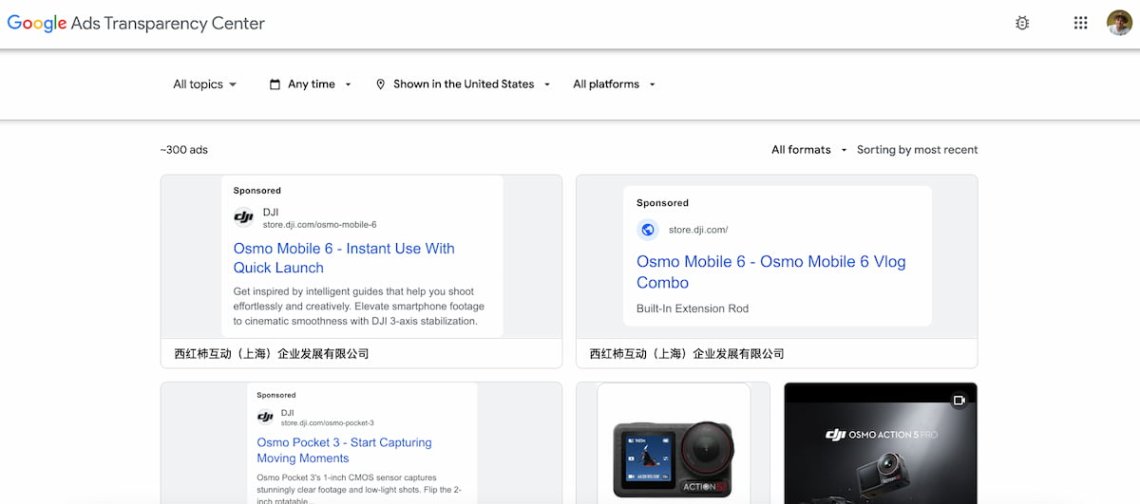
After clicking on a particular ad, you will be able to view the date it was last displayed.
05 Facebook ads
You can check the Facebook ads of your competitors quickly. All you need to do is to go to Meta Ad Library and type your competitor profile.
The tool will show you ads and sponsored posts published on Facebook, Instagram, Messenger, and Audience Network.
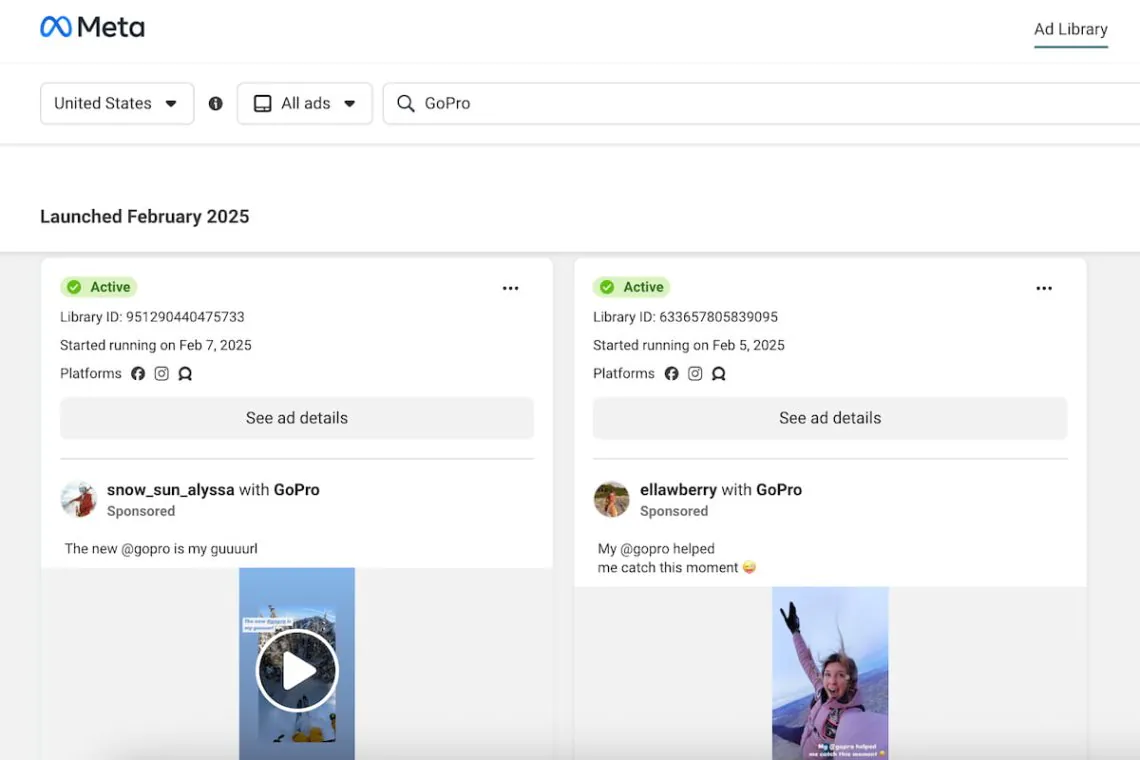
You can sort the data by the time range, keywords, language, platform, and media type.
Spy on your competitors! Monitor their social media!
06 Social media
There are three main reasons why following your competitors’ social media is a must:
- Running business profiles on social media is an extremely popular way of promotion and communication. In fact, nearly 94% of businesses use social media.
- Spying on your competitors on social platforms is relatively easy. They simply must be publicly available to serve their purposes effectively.
- Social media posts provide many great metrics that allow you to analyze competitor performance, such as engagement rates, follower growth, content types, and posting frequency.
These insights can help you understand what resonates with their audience and identify trends or gaps to leverage in your own strategy.
Okay, but how to spy on your competitor’s social media in practice? Well, there are two main ways:
- Follow their official accounts.
You can simply follow multiple competitors and create an Excel sheet where you will track key metrics such as posting frequency, types of content, engagement levels (likes, comments, shares), and any noticeable trends in their activity.
- Use social media monitoring tools.
I know that tracking competitors’ social media channels requires effort and time. You can use a social media monitoring tool to make this process faster and more digestible.
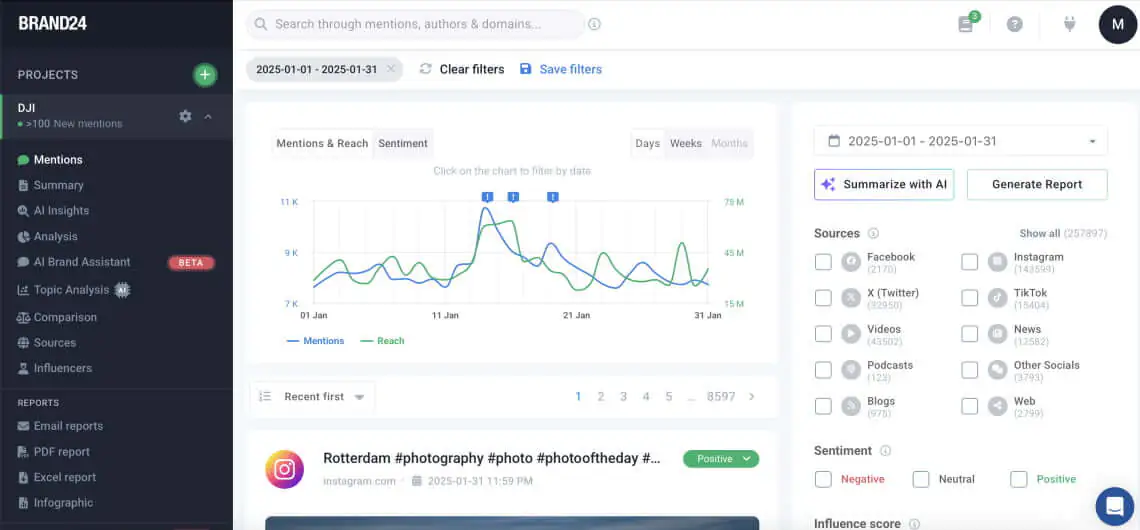
Spy on your competitors on social media & beyond!
Such a tool will help you:
- Monitor competitors’ profiles. You can add your competitors’ social media profiles to the monitoring tool. This gives you a dashboard to view all their activities across social platforms.
- Discover the top social media mentions & profiles. You can discover which influencers or accounts are engaging with your competitors the most, helping you identify potential partnerships or trends in their audience.
- Track any keyword or hashtag. You can set up specific keywords and hashtags related to your competitors’ brands or industries. The tool will then monitor posts containing these keywords, keeping you updated on relevant conversations.
- Set up alerts. Setting up alerts and notifications can give you an edge over your competitors by informing you of any increases in their mentions.
Okay, time for a little practice!
Let’s imagine you’re a GoPro representative spying on one of your main competitors – DJI. You’ve just created a project in Brand24 to track your rival’s performance.
With Brand24, you can discover your competitor’s social media performance in many ways.
In the case discussed, I used AI Topic Analysis, which recognizes discussion patterns and gathers mentions under common topics.
It turns out that DJI’s top social media mentions are related to content creation equipment and drone discussions.
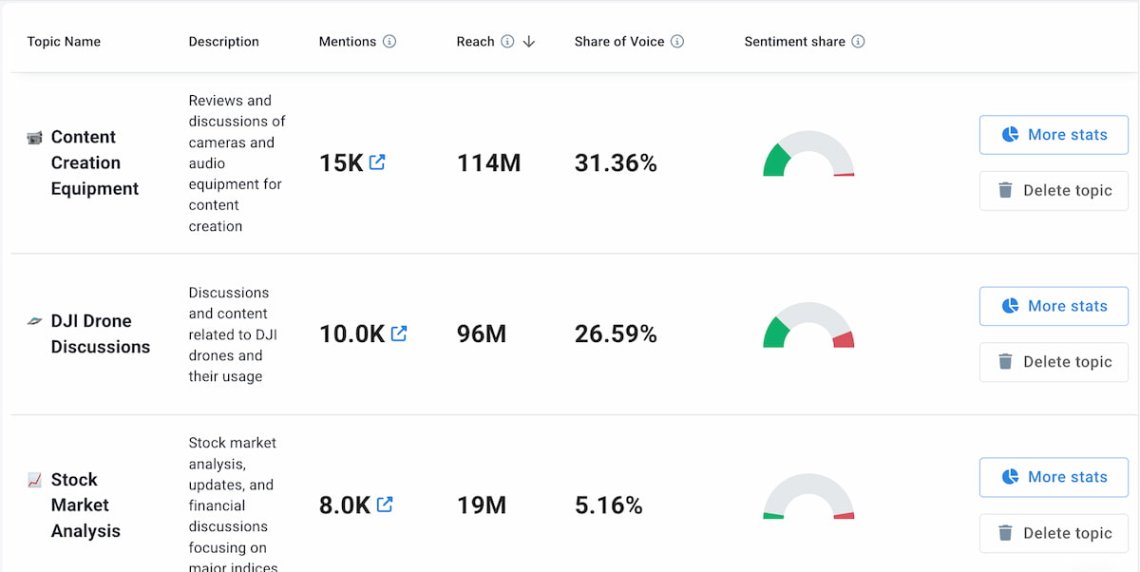
Spy on your competitors! Detect their online mentions!
07 Emoji
In their essence, emojis are designed to express or emphasize feelings. By analyzing them, you can gain insight into the emotional tone of conversations about your competitors.
In other words, you can discover what emotions your rivals stimulate across the target audience.
And there are tools for that purpose! For example, Brand24 can conduct emoji analytics.
According to their analysis, the DJI brand mainly receives positive emojis from its audience, indicating their admiration and joy towards the brand.
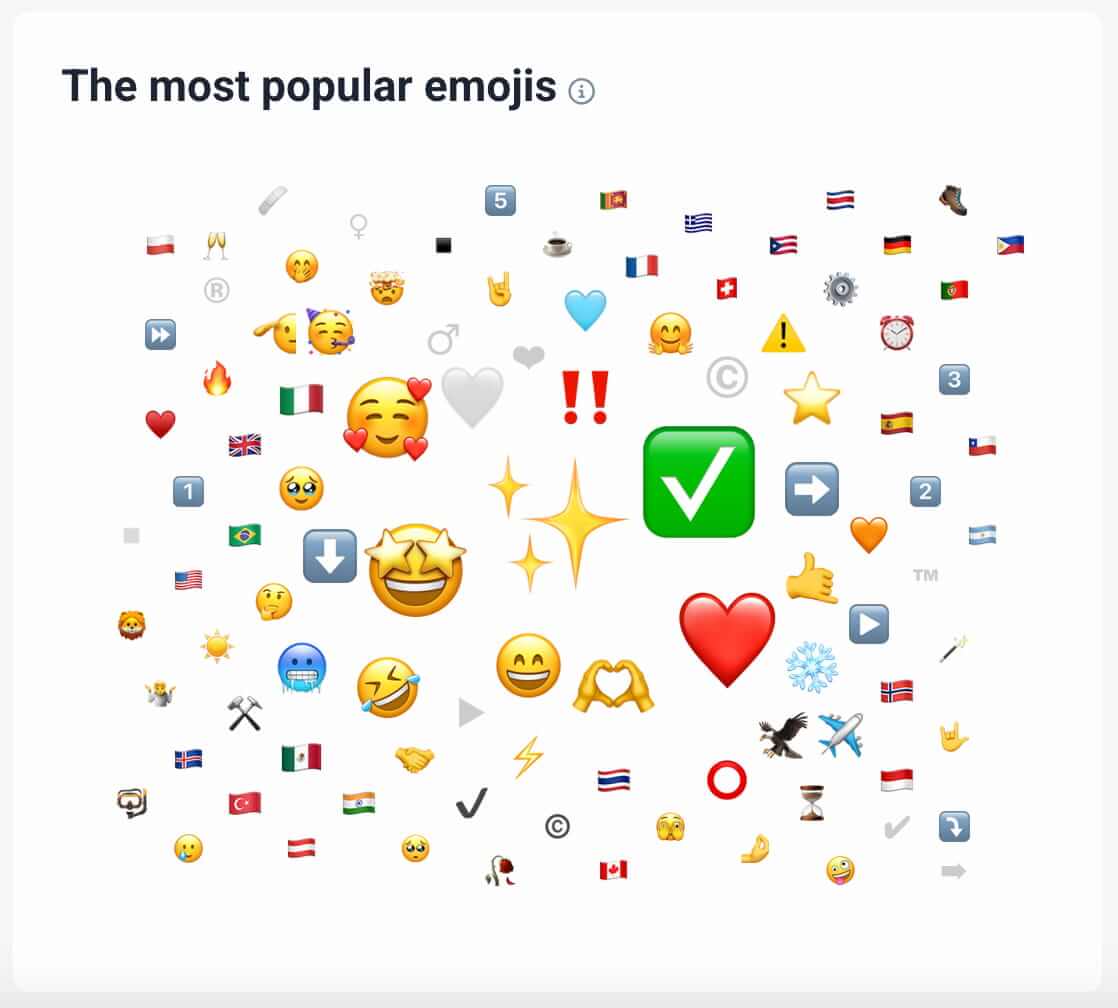
Spy on your competitors! Analyze their emojis!
08 Brand influencers & ambassadors
To detect your competitors’ ambassadors, you need to check who is talking about them.
The easiest way to do that is to use a tool designed for media monitoring and analyzing mentions. For example, Brand24 generates lists of influencers and detects discussion leaders.
Here you can see the DJI’s most impactful influencers from January 2025:
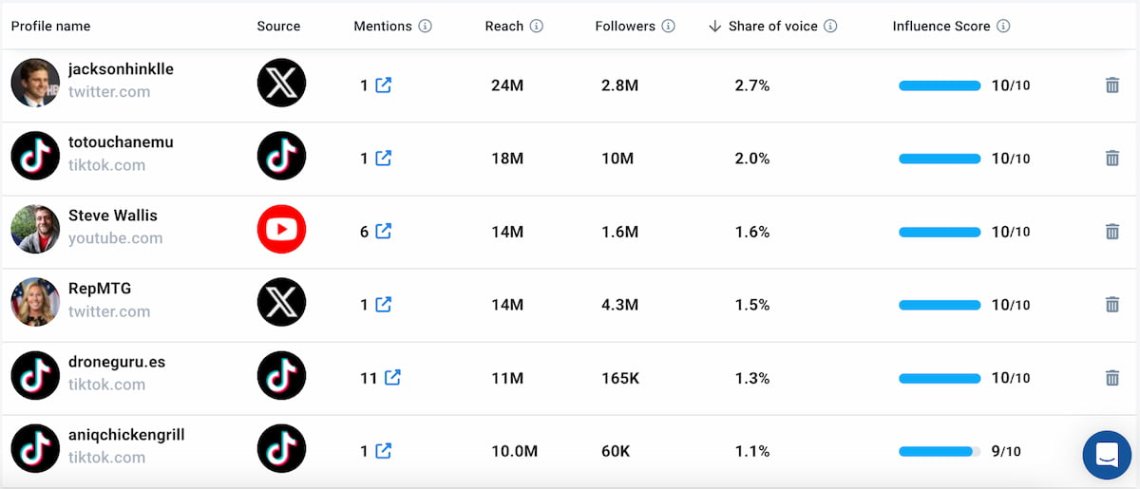
You can also see discussion leaders who talk about DJI positively or negatively:
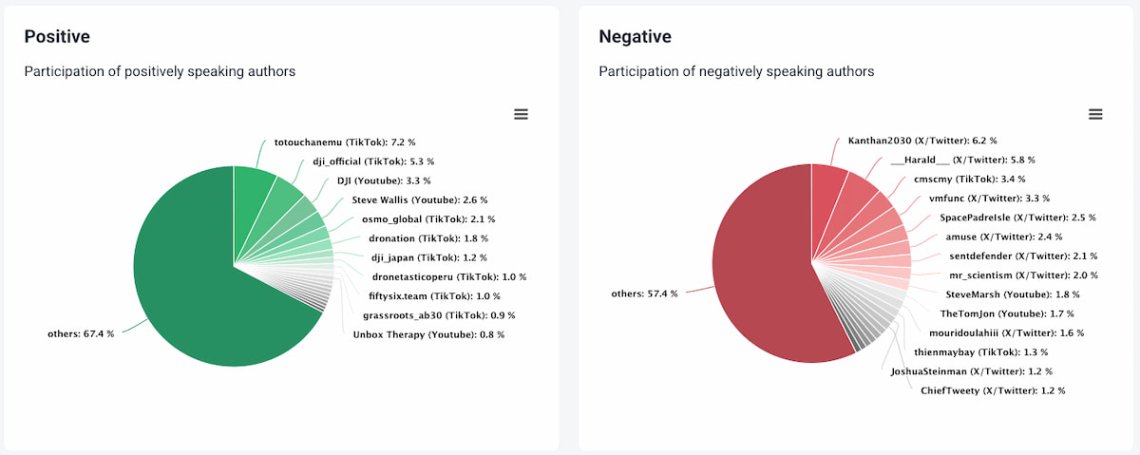
Spy on your competitors! Discover their top influencers!
09 Online Presence
How popular are your competitors? To answer this question, you need to check their Presence Score. This metric measures brand presence over a given period of time.
It’s also a useful tool to measure and benchmark brand awareness. Presence Score operates on a scale from 1 to 100. What’s Important 100 is a score achieved by globally recognizable brands.
The online presence of DJI is 81, which means it’s more popular than 90% of brands.
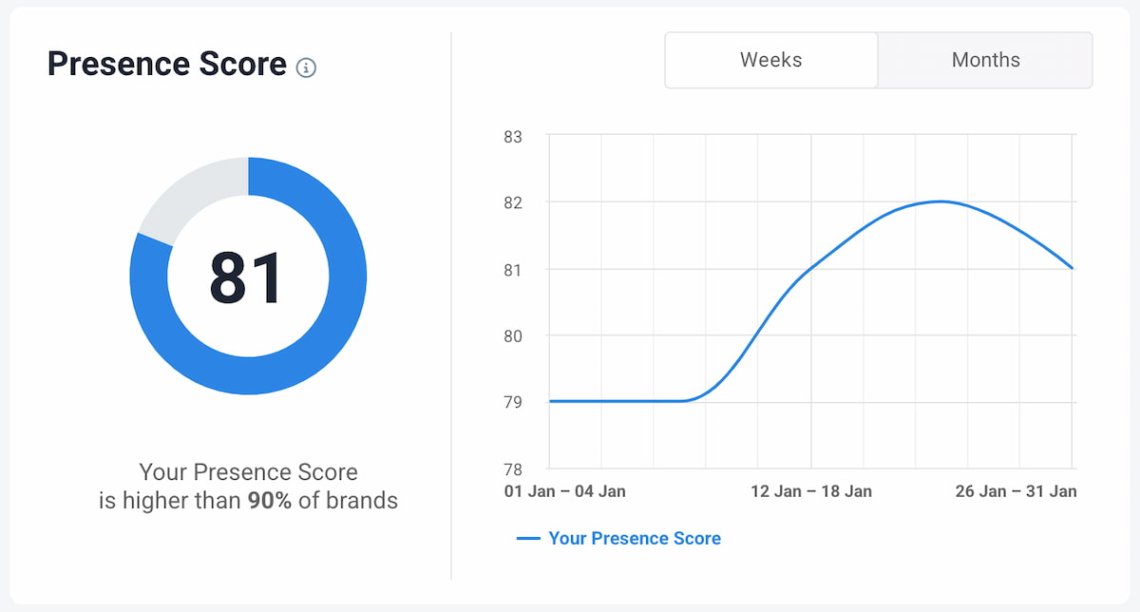
Spy on your competitors! Check their Presence Score!
10 Overall reach
Okay, in step 6, we discussed how to spy on competitor social media. But most likely, your rivals are present also through non-social sources.
Therefore, you should be able to track your competitors in as many places as possible. This will give you a comprehensive and much fuller picture of their reach across various touchpoints.
To make it clear, let’s underline the difference:
- Social media reach provides insights into your competitors’ online visibility and engagement on platforms like Facebook, TikTok, Instagram, and more.
- Non-social reach encompasses their presence beyond social media, such as blogs, news, podcasts, newsletters, forums, and review sites.
Let’s take a closer look at some insights.
In January 2025, DJI’s total reach was over 1.1 Billion, most of which was generated by neutral mentions (773M). The positive reach (276M) is over seven times higher than the negative one (39M).
The estimated social media reach was 967M, non-social reach was 144M.
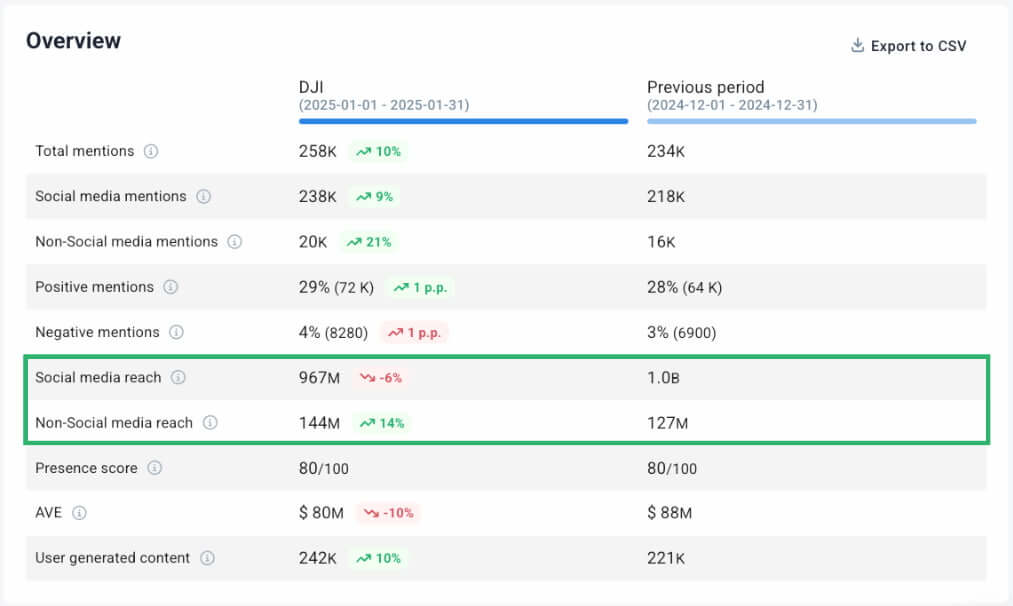
Now, let’s delve a bit deeper using the Brand24 AI Metrics Analysis.
It turns out that DJI’s most reach-efficient sources are “Other Socials” (Reddit, Quora, Telegram, etc.), video platforms (YouTube, Vimeo, etc.), and blogs.
That’s evidence that you shouldn’t limit yourself to tracking your competitors’ social media reach. To understand your rivals better, you must track both social and non-social sources.
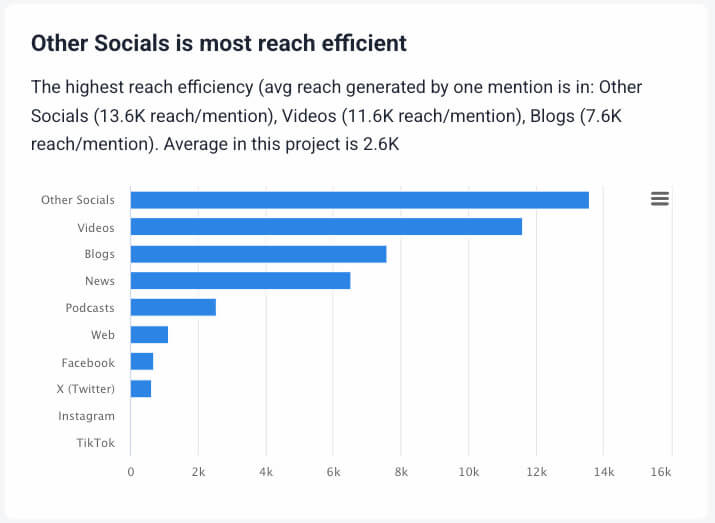
Spy on your competitors! Measure their reach!
11 Sentiment
Now, let’s find out what is the sentiment around your competitors.
To do that, you need to check whether Internet users write about them positively or negatively.
Fortunately, you don’t have to do it alone. Tools like Brand24 measure the sentiment surrounding each mention and turn those data into insights.
Below you can see DJI’s sentiment chart. Positive mentions clearly outweigh negative ones.
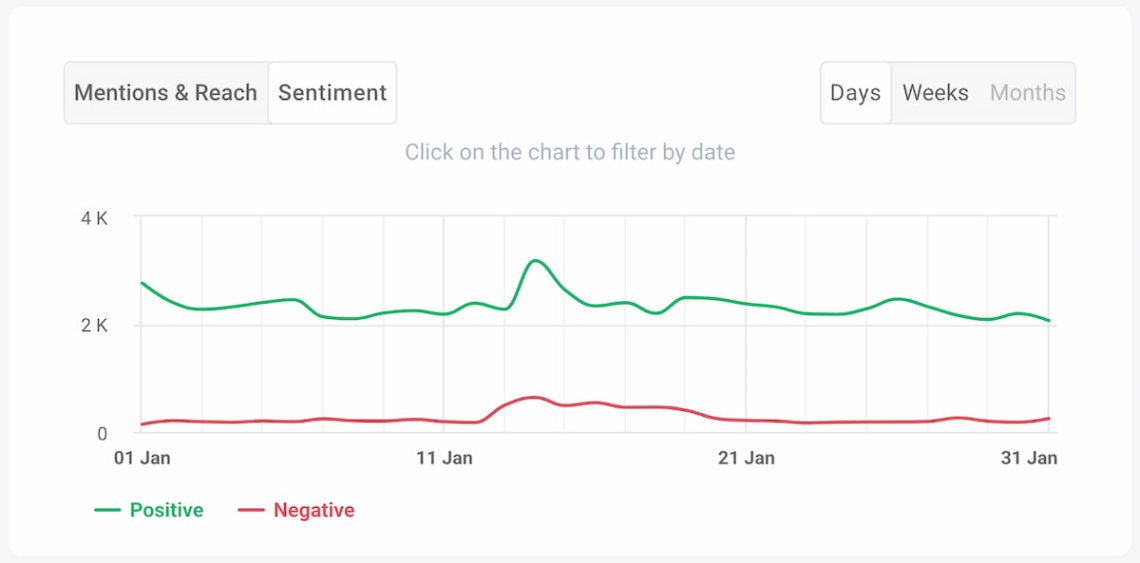
If you need more details, you can easily check the sentiment breakdown.
The most common feelings expressed when discussing DJI are neutral (69%). There are over 8.8 times more positive than negative mentions (28% vs. 3%). Conclusion?
DJI enjoys a great brand reputation!
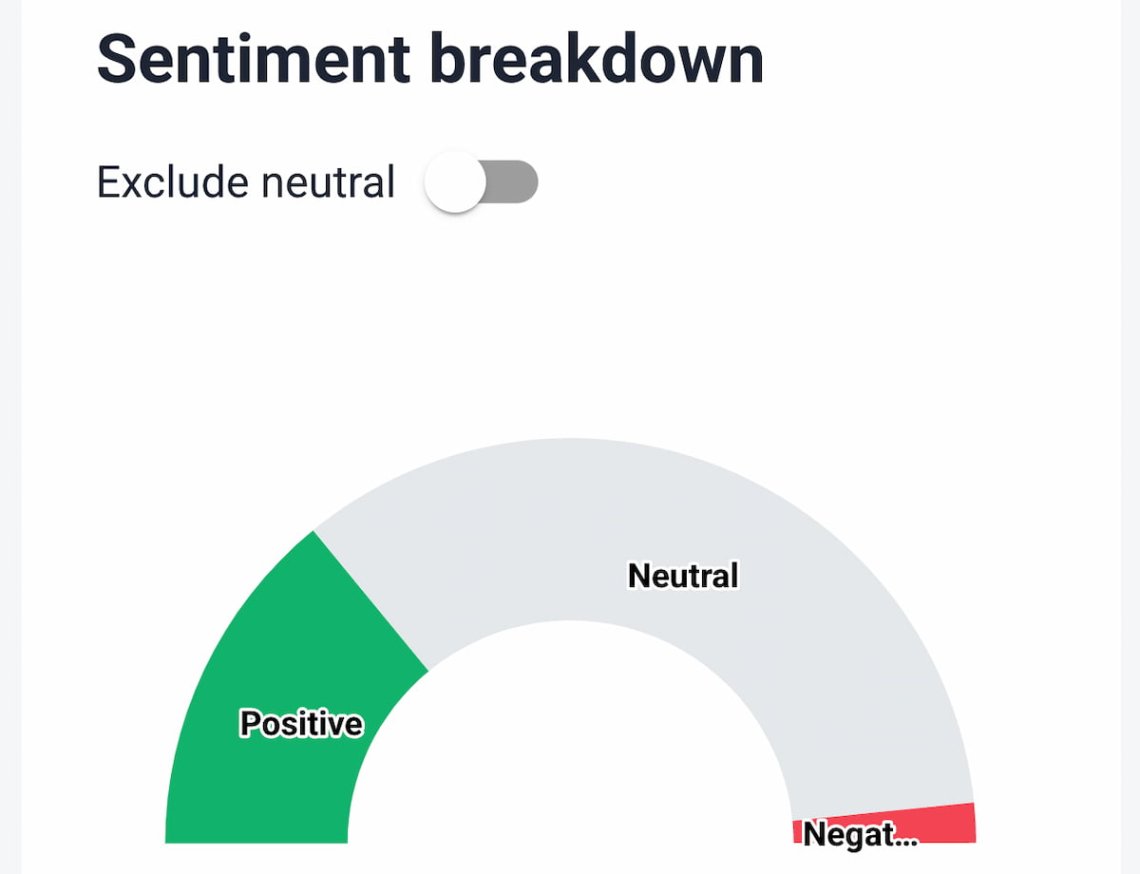
Spy on your competitors! Discover their public sentiment!
12 Competitors’ email marketing
Another technique that is very useful in the competitor research process is checking its email marketing strategy.
That’s pretty simple. Sign up for your competitors’ newsletters and analyze their email content over time. Pay attention to:
- Email frequency, so how often do they send emails;
- Subject lines, so what kind of headlines do they use to grab attention;
- Call-to-action (CTA) to understand if they use their email to push for sales, content engagement, or brand awareness.
- Promotions & offers to discover if they offer discounts, exclusive deals, or early access to products.
Analyzing these aspects will allow you to inspire yourself and better understand your competitors’ strategies.
Spy on your competitors! Detect their online mentions!
13 Competitor website traffic analysis
Understanding how much search traffic your competitor’s website grabs can help gauge their position in your industry or niche.
Let’s find out how much traffic the GoPro website has compared to its market rivals, DJI and Insta360.
According to Semrush, in January 2025, gopro.com had 6.1 million total visits. In the analogous period, the Insta360 website was visited 5.3 million times, while dji.com was visited over 22 million times!
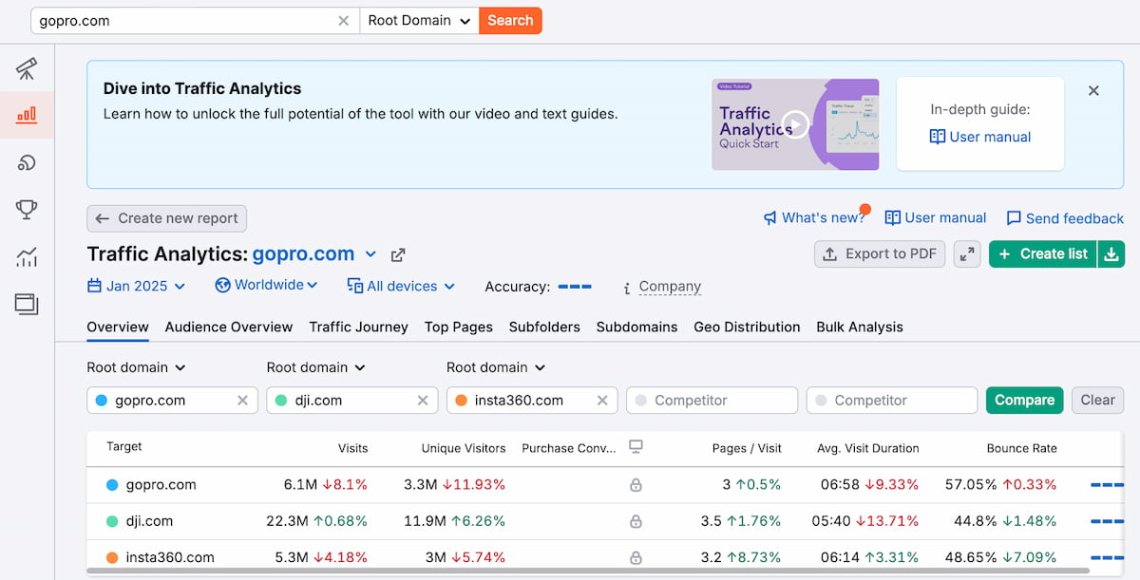
By checking which sources (organic search, paid search, social media, referrals, etc.) drive most of your competitor’s website traffic, you can identify where you might be under-investing.
As you see, DJI is drastically beating its competitor websites in direct, referral, and organic search traffic.
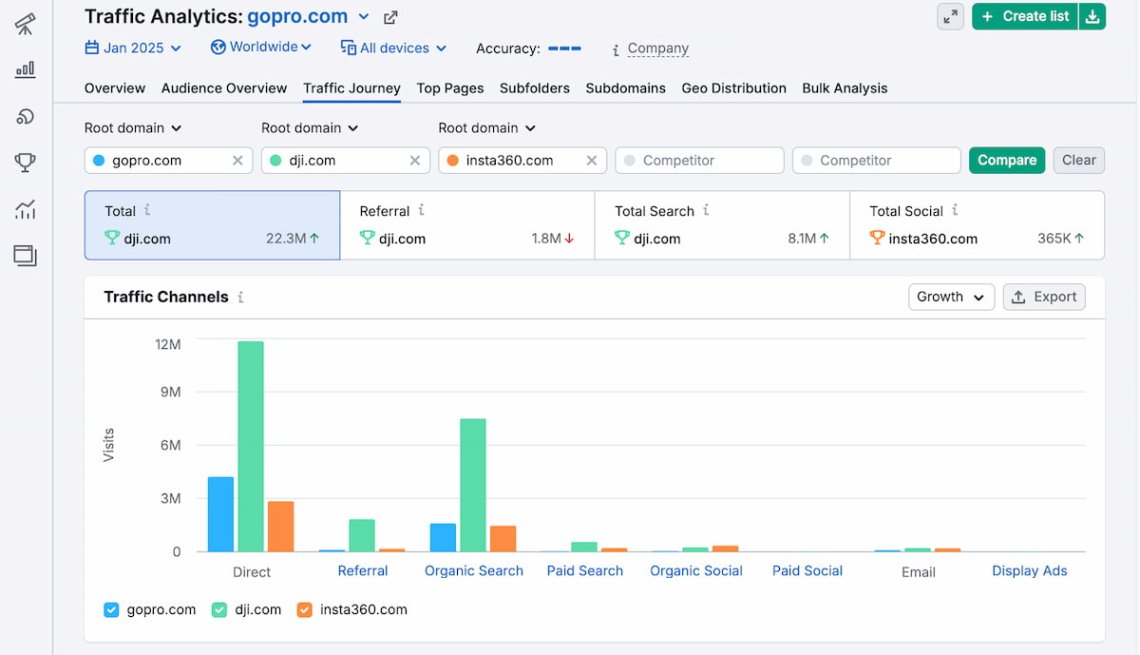
14 Website changes
Did you know that you can spy on competitor’s website changes?
Tools like Visualping monitor whether your competitor changed the elements that might influence your business decisions, such as pricing, updating the pages, or other important modifications.
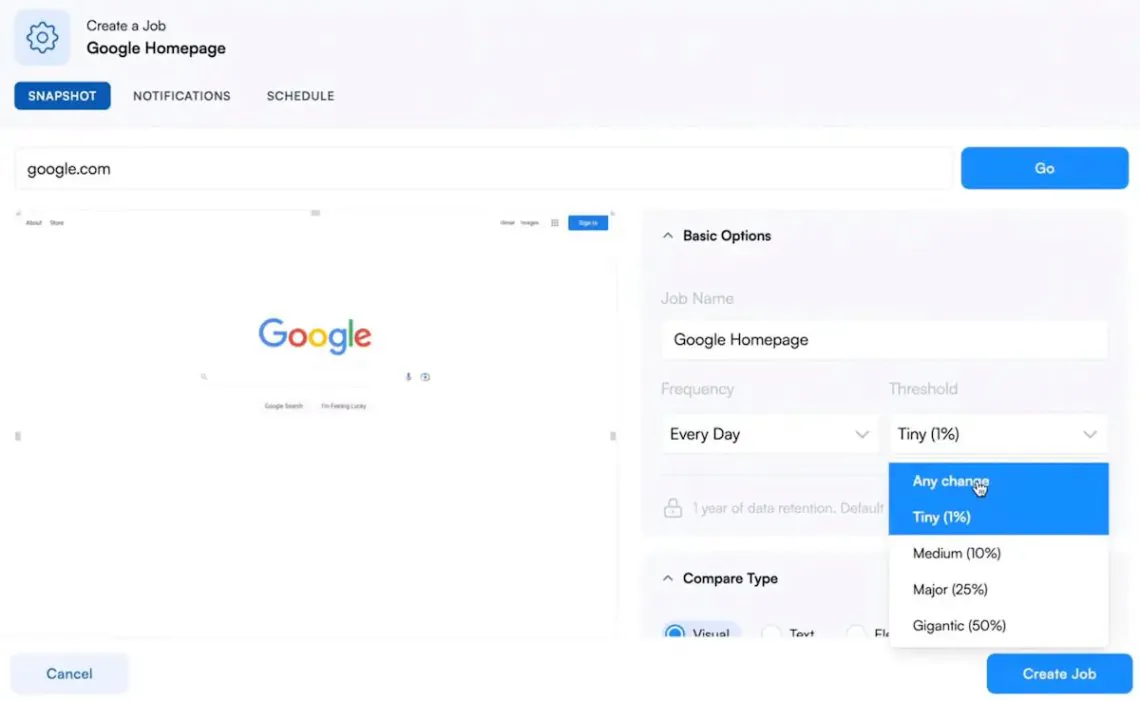
If a competitor changes their website design or navigation, this could indicate that they are focusing on improving their user experience.
This could be a good opportunity for you to assess your own site’s UX and see if any areas could be improved.
Spy on your competitors! Detect their online mentions!
15 Backlinks
Backlinks monitoring is a critical aspect of a comprehensive SEO strategy. Why?
Because who and how links to your (or your competitors’) websites is a strong ranking factor influencing positioning in search engines like Google.
If a trustworthy website provides links to your competitors, there’s a good chance that they’ll be interested in linking to your content as well.
Let’s discover how to find out competitors’ backlinks. Again, you can use Semrush for this purpose.
The tool analyzes a backlink profile. So you can check the domain authority, the number of backlinks, anchor texts, types of links, and many other essential elements.
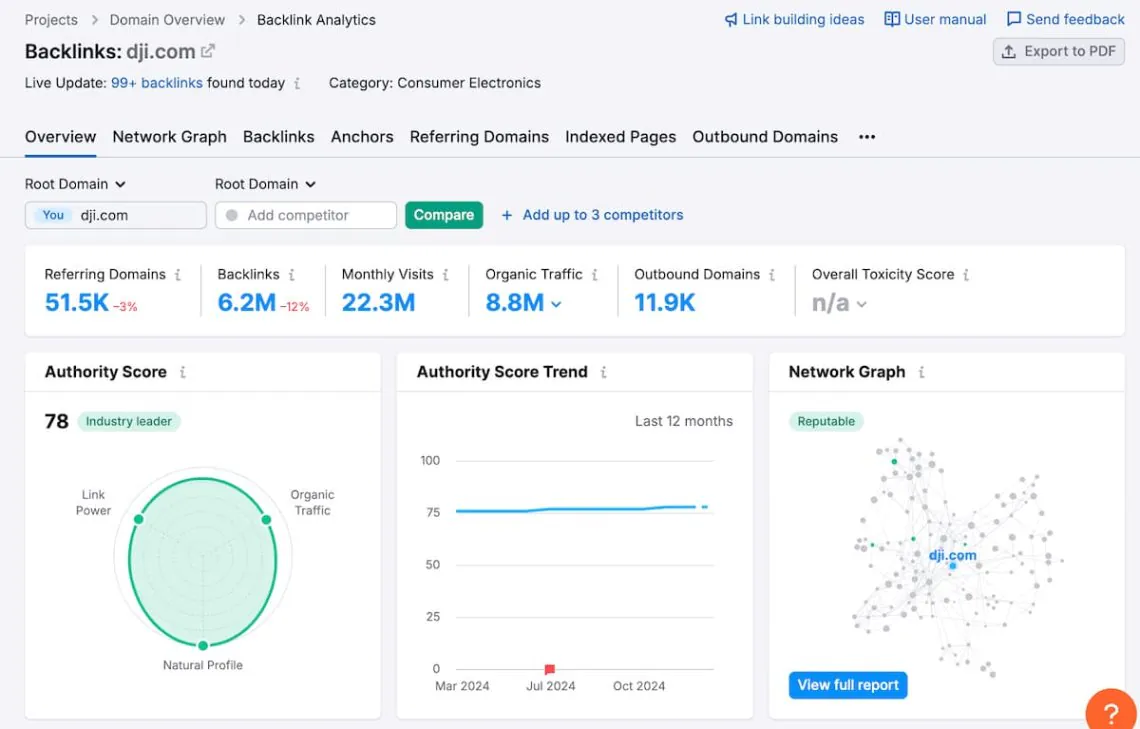
You can also check a detailed list of backlinks:
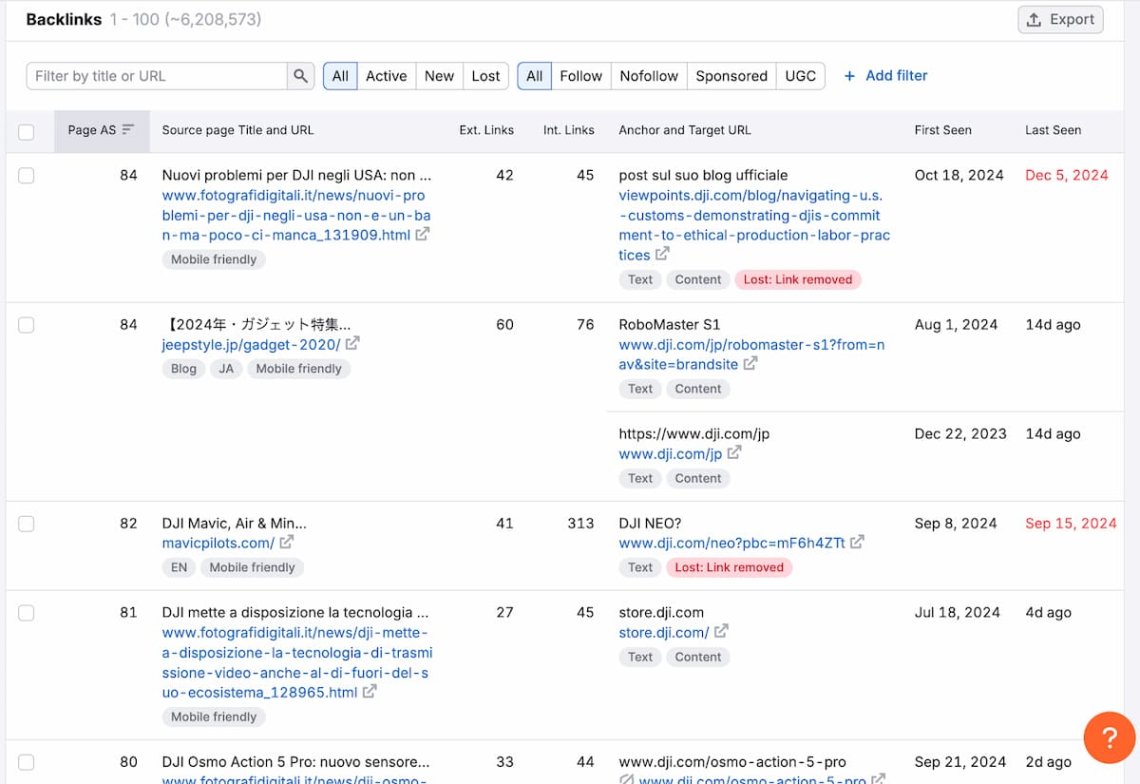
Want more backlinks to your website? Find unlinked brand mentions and turn them into backlinks.
Read more about spying on your competitors using the Backlinks Checker.
16 Technology
If your competitors leverage cutting-edge technology, it might be a competitive advantage for them.
By identifying the technologies that give them an edge, you can incorporate similar tools or develop alternative solutions.
Thanks to tools like Wappalyzer, I discovered that dji.com uses Amazon Web Services, Google Tag Manager, AMP JavaScript framework, and much more.
You can easily implement the free version of Wappalyzer as a browser extension.
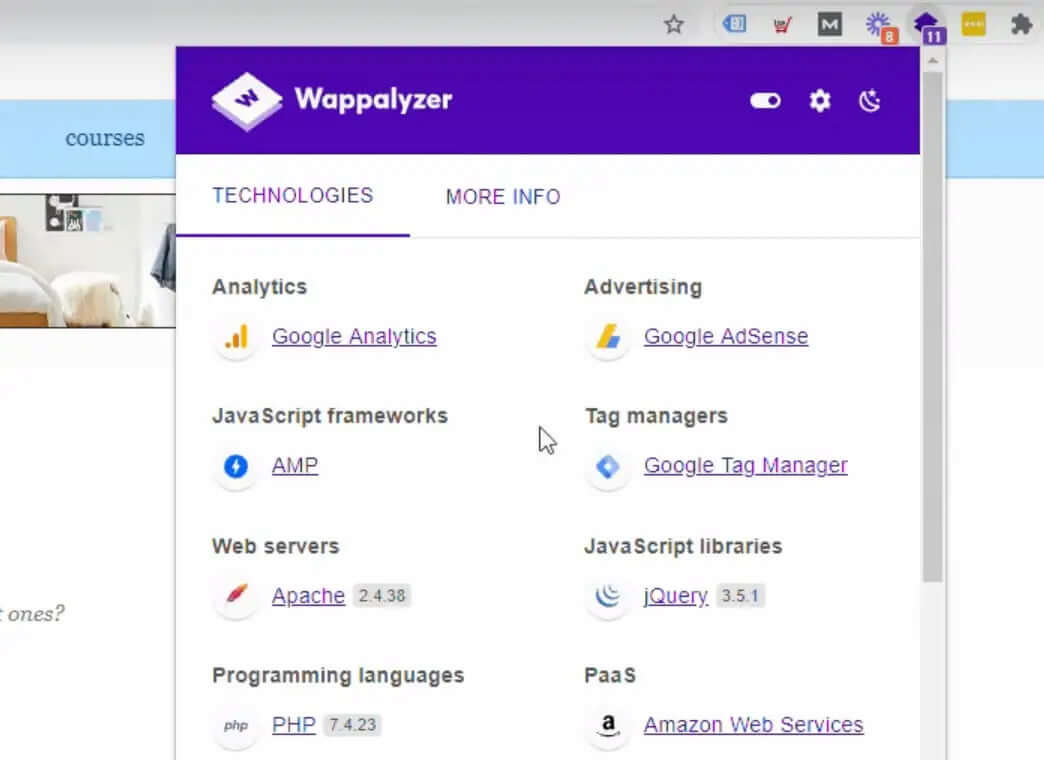
Spy on your competitors! Detect their online mentions!
Conclusion
Spying on competitors is not about secrecy; it’s about smart research.
You can uncover many valuable insights by analyzing keywords, mentions, ads, social media, and other publicly available sources.
Dive deeper into how global giants like Amazon, Uber, Boeing, and Airbnb battle for market dominance.
When doing so, use the power of tools like Brand24 or Semrush. They make the process much easier, faster, and more effective.
With the right data, you can refine your business & marketing strategy, gain a competitive edge, and overtake your competitors.
So, start monitoring, keep adapting, and stay ahead in the game!
Final thoughts:
- Always start by defining your competitors. Working backward doesn’t pay off.
- To get a more comprehensive picture of your competitors, you should analyze both their social and non-social media performance.
- Trends change, and so do competitors. Regularly updating your research ensures you don’t fall behind.
- Focus on insights, not just data. Numbers matter, but what you learn from them is what drives real growth.
Start a Brand24 14-day free trial and spy on your competitor now!




